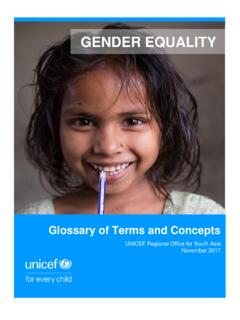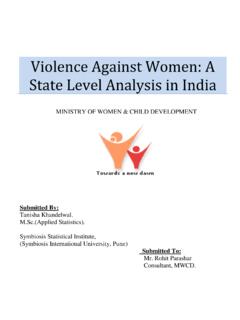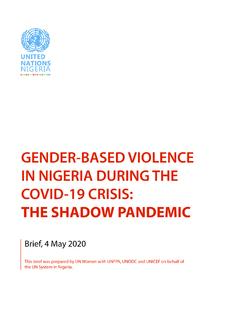Transcription of GENDER TOOLKIT - UNICEF
1 Integrating GENDER in Programming for Every Child in South AsiaUNICEF REGIONAL OFFICE FOR SOUTH ASIA GENDER TOOLKITC opyright UNICEF South AsiaDecember 2018 Acknowledgements:This document has been prepared by the UNICEF ROSA GENDER Section to provide guidance to enhance GENDER integration in UNICEF Programming in South GENDER TOOLKIT was produced under the leadership of the UNICEF ROSA Regional GENDER Adviser, Sheeba HarmaStrategic guidance Deputy Regional Director, Philippe Cori Technical contents and graphic design GENDER Development Officer, Rui NomotoInputs and suggestions GENDER Consultants, Navanita Sinha and Julia StewartDesign and Printing, Jagadamba Press, KathmanduValuable inputs were also received from various programme sections at the Regional Office and from Country online version is available at TOOLKITI ntegrating GENDER in Programming for Every Child in South AsiaUNICEF REGIONAL OFFICE FOR SOUTH ASIAFOREWORDI am very pleased to share with you all the first GENDER TOOLKIT prepared by UNICEF Regional Office for South TOOLKIT includes guidance on how to undertake a GENDER analysis.
2 What needs to be in place to ensure GENDER is mainstreamed effectively and how GENDER can be integrated into the Regional Headline Results (Save New Borns, Stop Stunting, Every Child Learns and End Child Marriage) and in our Complementary Results for Early Childhood Development (ECD) and Water, Sanitation and Hygiene (WASH). The South Asia Headline Results are cross cutting in nature where GENDER has a critical role in achieving and sustaining the results. Many offices in this region are also implementing a life cycle approach to programming where achievement of results will depend on the integration of GENDER issues. If we are not addressing GENDER issues, norms, barriers and inequalities in our planning and implementation, we will not be able to achieve and reach our overall results and societal change will not be TOOLKIT is a much needed practical resource to help all country offices in this region (Afghanistan, Bangladesh, Bhutan, India, Maldives, Nepal, Pakistan and Sri Lanka) to plan and integrate the different needs, capacities and engagement of girls and boys, women and men in your programmes and outcomes.
3 We hope you will find this resource to be useful to drive change in your programming approaches and urge you to apply this to improve the quality of your results. Jean GoughRegional DirectorUNICEF Regional Office for South Asia (ROSA)SECTION 1 SECTION 2 ANNEXT oolkit contentsAcronymsPage IWater, Sanitation and HygieneEarly Childhood Development SECTION 3 Introduction to the ToolkitPage IIGender Concepts and UNICEF s GENDER CommitmentsPage 1 Practical Steps for GENDER MainstreamingPage 17 SECTION 3 GENDER Integration in Regional Headline Results and Complementary Results Glossary of Terms and ConceptsSave Newborns Stop StuntingEvery Child LearnsEnd Child Marriage ..the benefits of GENDER equality go beyond their direct impact on children. Without it, it will be impossible to create a world of equity, tolerance and shared responsibility a world that is fit for children. The State of the World s Children 2007 GENDER TOOLKIT | ICEDAWC onvention on the Elimination of all Forms of Discrimination Against WomenC4 DCommunication for DevelopmentCOCountry OfficeCOARC ountry Office Annual ReportCPDC ountry Programme DocumentsCRCC onvention on the Rights of the ChildCSOsCivil Society OrganizationsDHSD emographic and Health SurveysECDE arly Childhood DevelopmentFGM/CFemale Genital Mutilation/CuttingGAPG ender Action PlanGBVG ender-Based ViolenceGEMG ender Equality MarkerHIV/AIDSH uman Immunodeficiency Virus/Acquired Immune Deficiency SyndromeHQHeadquartersINGOsInternational Non-Governmental OrganizationsKAPK nowledge.
4 Attitudes and PracticesM&EMonitoring and EvaluationMHMM enstrual Hygiene ManagementMICSM ultiple indicator Cluster SurveyMODAM ultiple Overlapping Deprivation AnalysisMTRMid Term ReviewNGOsNon-Governmental OrganizationsOECDO rganisation for Economic Co-operation and DevelopmentRAMR esult Assessment ModuleRORegional OfficeSDGsSustainable Development GoalsSitAnSituation AnalysisSRHRS exual and Reproductive Health and RightsUNUnited NationsUNDAFU nited Nations Development Assistance FrameworkUNDPU nited Nations Development ProgrammeUNICEFU nited Nations Children s FundUPRU niversal Periodic ReviewWASHW ater, Sanitation and HygieneWHOW orld Health OrganizationAcronymsII | UNICEF Regional Office for South AsiaIntroduction to the TOOLKIT Purpose of the toolkitThe concepts, process and benefits of integrating GENDER equality issues have not always been sufficiently understood and incorporated into UNICEF s programming across South Asia. This TOOLKIT is a step towards strengthening the institutional and individual capacity to undertake GENDER mainstreaming in UNICEF s programmes and to advance policy commitments on GENDER equality.
5 This TOOLKIT provides practical guidance to assist UNICEF staff to effectively integrate GENDER into all aspects of their work and all stages of the programme cycle. The empowerment of women and girls is most effective if GENDER is a primary focus of all interventions starting with assessment, analysis and design phases and through to implementation, monitoring and evaluation. This TOOLKIT is intended to be adapted to the goals and objectives of interventions in each country context, and used alongside other UNICEF s guidance is this TOOLKIT for?This TOOLKIT has been prepared for UNICEF professionals at all levels in the South Asia region, working on GENDER interventions at national and subnational levels including GENDER focal points and specialists, non- GENDER specialists, management, sector staff and planning, monitoring and evaluation (PME) teams. It may also be a useful resource for government stakeholders working closely with UNICEF and for implementing partners working towards GENDER equality.
6 Inside the toolkitThe TOOLKIT is composed of three sections. Section 1 takes a broad look at GENDER integration in programming and UNICEF s approach to GENDER equality. Section 2 provides practical steps on integration of GENDER across the UNICEF Country Programme Development (CPD) cycle. Section 3 comprises six modules that offer guidance on GENDER integration across the UNICEF South Asia Regional Headline Results and its Complementary Results covering health, nutrition, education, child protection, water, sanitation and hygiene (WASH) and Early Childhood Development (ECD). GENDER indicators are found in each of these modules. Finally, the Annex includes a glossary of GENDER -related terms and TOOLKIT | 1 SECTION 1 GENDER Concepts and UNICEF s GENDER Commitments2 | UNICEF Regional Office for South AsiaI. ESSENTIAL GENDER CONCEPTSF amiliarize UNICEF programme officers and practitioners with the specialized vocabularies associated with GENDER equality and bring conceptual clarity on the themes are essential to the design, implementation and evaluation of UNICEF programmes.
7 Below are some key definitions of GENDER terms that will be helpful in utilizing this TOOLKIT . More definitions and terms are available in the separate Annex : Glossary of Terms and GENDER TERMSSex and GenderThe term sex is defined to mean the biological differences between women and men. GENDER refers to the social relationships between women, men, girls and boys that vary from one society to another and at different points in history. GENDER rolesGender roles are learned from the time of birth and are reinforced by parents, teachers, peers and society. These GENDER roles are based on the way a society is organized and vary by age, class and ethnic normsGender norms are the accepted attributes and characteristics of male and female gendered identity at a particular point in time for a specific society or community. They are the standards and expectations to which GENDER identity generally conforms, within a range that defines a particular society, culture and community at that point in time.
8 GENDER norms are ideas about how women, men, girls and boys should be and act. Internalized early in life, GENDER norms can establish a life cycle of GENDER socialization and stereotyping. GENDER relationsGender relations have to do with the ways in which a culture or society defines rights, responsibilities and the identities of women, men, girls and boys in relation to one another. GENDER relations refer to the balance of power between women and men or girls and boys. GENDER TOOLKIT | 3 GENDER equityGender equity is the process of being fair to both women (girls) and men (boys) in distribution of resources and benefits. This involves recognition of inequality and requires measures to work towards equality of women (girls) and men (boys). GENDER equity is the process that leads to GENDER equality. GENDER parityGender parity is a numerical concept. GENDER parity concerns relative equality in terms of numbers and proportions of women and men, girls and boys. For example, the ratio of girls and boys enrolled in school.
9 EmpowermentEmpowerment is about women, men, girls and boys taking control over their lives: setting their own agendas, developing skills (including life skills), building self-confidence, solving problems and developing self-reliance. The process of empowerment enables women, men, girls and boys to question existing inequalities as well as act for analysisGender analysis is an organized approach for considering GENDER issues through the entire process of programme or organizational development. This requires sex-disaggregated data and ensures that development projects and programmes incorporate roles, needs and participation of women, men, girls and equalityGender equality is a transformational development goal. It is understood to mean that women (girls) and men (boys) enjoy the same status on political, social, economic and cultural levels. It exists when women (girls) and men (boys) have equal rights, opportunities and | UNICEF Regional Office for South AsiaPractical needsPractical needs are immediate perceived needs such as water, shelter, clothing, basic health care and food.
10 They are based on women s and girls existing roles (within the GENDER division of labour) and do not challenge their subordinate position. These needs arise from and reinforce women s and girls reproductive and productive roles. Strategic needsStrategic needs are long-term in nature and often related to structural changes in society. These are identified based on an analysis of women s and girls subordination in society, and when addressed, should lead to the transformation of the GENDER division of labour and challenge the power relations between women and men, girls and mainstreamingGender mainstreaming is the process of assessing implications for women, men, girls and boys of any planned action including legislation, policies or programmes at all levels. It refers to a strategy for making women s, men s, girls and boys concerns and experiences an integral dimension of design and implementation, monitoring and evaluating policies and programmes in all political, economic and societal spheres so that women and girls can benefit equally and inequality is not perpetuated.














